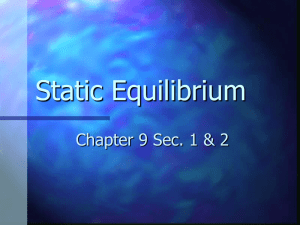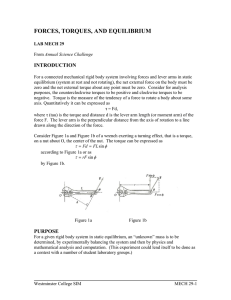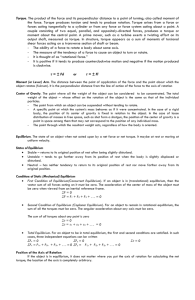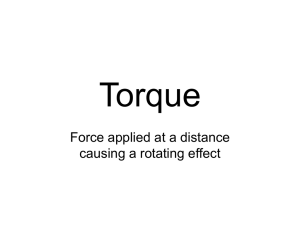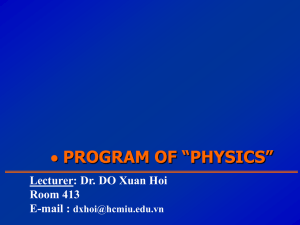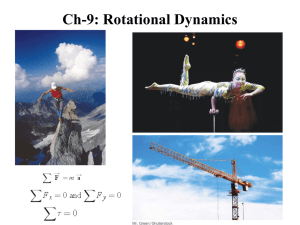Equilibrium I - Basics
advertisement
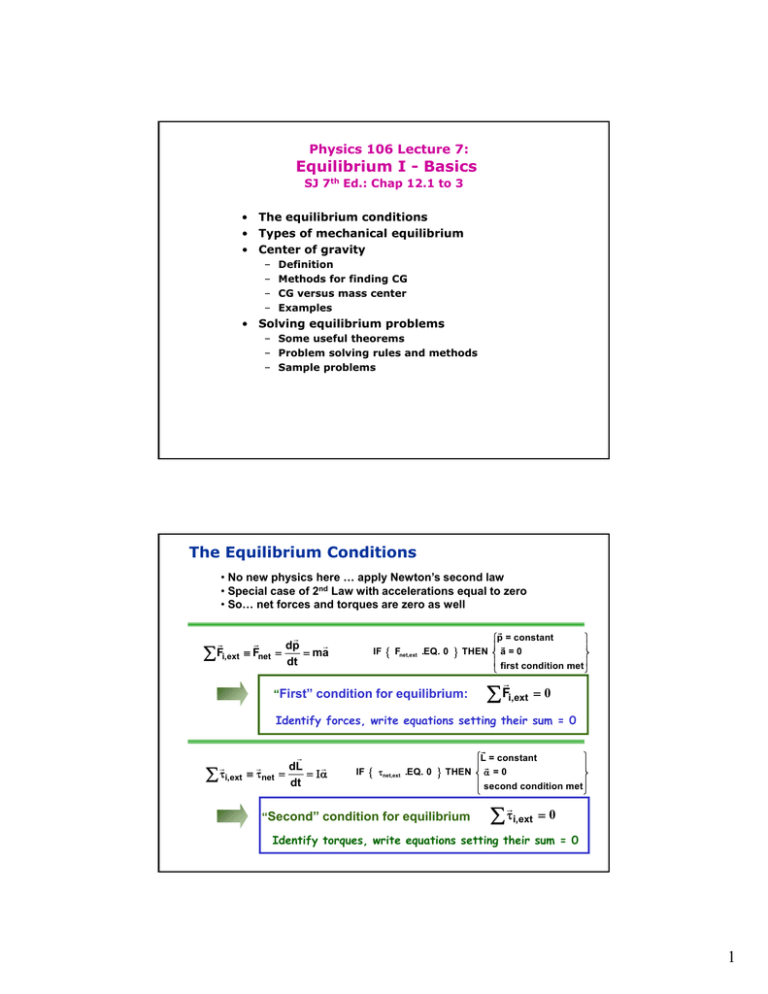
Physics 106 Lecture 7:
Equilibrium I - Basics
SJ 7th Ed.: Chap 12.1 to 3
• The equilibrium conditions
• Types of mechanical equilibrium
• Center of gravity
–
–
–
–
Definition
Methods for finding CG
CG versus mass center
Examples
• Solving equilibrium problems
– Some useful theorems
– Problem solving rules and methods
– Sample problems
The Equilibrium Conditions
• No new physics here … apply Newton’s second law
• Special case of 2nd Law with accelerations equal to zero
• So… net forces and torques are zero as well
G
G
G
G
dp
F
≡
F
=
∑ i,ext net dt = ma
IF
{
Fnet,ext .EQ. 0
}
G
⎧p = constant
⎫
⎪ G
⎪
THEN ⎨ a = 0
⎬
⎪
⎪
⎩ first condition met ⎭
G
“First” condition for equilibrium:
∑ Fi,ext = 0
Identify forces, write equations setting their sum = 0
G
dL
G
G
G
τ
≡
τ
=
∑ i,ext net dt = Ια
IF
{
τnet,ext .EQ. 0
}
G
⎧L = constant
⎫
⎪ G
⎪
THEN ⎨ α = 0
⎬
⎪ second condition met ⎪
⎩
⎭
“Second” condition for equilibrium
G
∑ τi,ext = 0
Identify torques, write equations setting their sum = 0
1
ISOLATED SYSTEM
MECHANICAL EQUILIBRIUM
No change in translational or rotational “state”
constant momentum, zero net force, constant angular momentum, zero net torque
zero linear acceleration of particle or cm of rigid body, zero angular acceleration of rigid body
MECHANICAL EQUILIBRIUM: DYNAMIC VERSUS STATIC
Dynamic: ΣF = 0 and Στ = 0....BUT... p and/or L are not = 0
Static: In addition, p = 0 and L = 0
STABILITY OF STATIC EQUILIBRIUM
Imagine displacing system a small amount: does it return?
stable
unstable
EXAMPLES: book on table
puck sliding on ice
ceiling fan – on
ceiling fan – off
car on straight road
car on curve
ladder leaning against wall
neutral
static
dynamic
dynamic
static
dynamic
not equilibrium
static
neutral
--neutral
--unstable (friction)
stable (foot in groove)
Definition: The center of gravity of a body is the point
about which all of the torques due to gravitational
forces sum to zero
•
•
•
•
CG is about torques – gravitational torques
A body is “balanced” if it is in rotational equilibrium
Gravitational torques cancel about the CG
A single support force through CG creates zero torque (moment arm = 0)…
... but ensures zero net force on system (linear equilibrium)
• CG often coincides with mass center (CM)
... but may not if gravity varies across the body
balance a ruler
see-saw
L
L1
m
m1
a box about to tip
L2
m2 < m1
A single non-gravitational normal force applied at the CG can
produce translational equilibrium
2
What’s the Difference Between CG and CM?
Definition of Mass Center for point particles:
G
rcm ≡ (x cm , ycm , z cm ) ≡ x cm î + ycm ĵ + z cmk̂
•
Divide object into many small
particles
– Each particle has a specific
mass and specific coordinates
•
The x coordinate of the center of
mass is a mass-weighted average
of the position coordinates:
xCM =
∑m x
∑m
i
G
rcm
i
i
i
•
i
Similar expressions
for the y and
z coordinates
x cm =
∑xm
∑m
i
i
ycm =
i
∑ym
∑m
i
i
z cm =
i
∑zm
∑m
i
i
i
Depends only on mass distribution
No consideration of gravity needed
What’s the Difference Between CG and CM?
CM is determined by mass distribution alone,
i.e. by geometry & density function of body
CM would be the same on any planet
CG also depends on uniformity of local gravity field
CG might be shifted away from CM when g is not uniform
If density and gravity are both uniform
- CG, CM, and geometrical center all coincide
Uniform Gravitational Field
CG coincides with CM
CG Near left end
CM still at midpoint
CM
CM
X
X
Super dense material
From neutron star
3
G
The CG and CM coincide when g is uniform across a body
Proof: Consider a set of particles and a rotation axis at the origin
Find net torque due to gravitational forces alone
G
G
K G
G
K
τ g,net = ∑ τ g,i = ∑ ri × Fg,i = ∑ ri × migi
direction the gi’ss factor out
If gravitation has uniform magnitude and direction,
G
G
G
τ g,net = [ ∑ miri ] × g =
G
∑ miri × MgG
M
Total weight Fg acting
at the CM
Definition of mass center
relative to origin
∴
K
K
G
∴ τ g,net = rcm × Fg
G
(when g is uniform)
To put
p t he body
bod into equilibriu
eq ilibri m (balance),
(balance) support
s pport it with
ith a force equal
eq al
G
to Fg applied at the center of gravity rcg
G
∴
...the torque would be equal and opposite to τnet above.
...the external
K
K force cancels the net g force
rcm is the same as rcg - the CG location.
Also, the net gravitational torque on a rigid body about any axis equals that
produced if the weight were a point mass at the center of gravity – see below
Example: Find the balance point (CG) for a massless see-saw
FBD
L
x
m1
s
m2
balance point = CG
m1g
N
s
L-s
m2g
Balance means: put the support force N (= total weight) at a point such that
•
system does not accelerate linearly (static translational equilibrium)
•
angular
l acceleration
l
i
is
i also
l zero (rotational
(
i
l equilibrium)
ilib i )
To locate CG coordinate “s”
• Evaluate torques around CG, including only gravitational forces
• Assume support force N is applied at CG, exerting zero torque
1)
∑ τcg =
0 ⇒ m1gs − m2g(L − s) + N x 0
∴ s =
2)
∑ Fy =
m2
L
(m1 + m2 )
locates cg
Ex: Let m1 = 2m2
then s = 1/3 L
0 ⇒ (m1 + m2 )a = 0 = N − m1g − m2g
∴ N = (m1 + m2 ) g
total weight
Actually, if an object is in equilibrium, then the net torque = 0 for any axis
chosen (more below). For an axis away from CG, torque due to N is not
zero but still cancels the gravitational torques
4
Center of gravity for a sledge hammer
7.1. The center of gravity for a sledge hammer lies on the centerline of
the handle, close to the head, at the X mark. Suppose you saw across
the handle through the center of gravity, cutting the ax in two pieces.
You then weigh both pieces. Which of the following will you find?
x
A)
B)
C)
D)
The handle piece is heavier than the head piece
The head piece is heavier than the handle piece
The two pieces are equally heavy
The comparative weights depend on more information
Definition: The center of gravity of a body is
the point about which all of the torques due
to gravitational forces sum to zero
The torque on a body due to gravity equals the torque
gravity would exert on a point mass with same weight
(magnitude and direction) located at the CG
Proof:
Assume a collection of particles { mi }
Arbitrary rotation axis at “O”
Include only gravitational forces
G G
G
G
ri = ri' + rcg where... rcg = CG location
G
ri ≡ particle coordinate relative to O
G
ri' ≡ particle coordinate relative to cg
G
τ g,net ,O =
K
G
G
G
K
rcg
O
G
G
∑ ri × Fg,i ≡ ∑ ri × migi = ∑ ri ' × migi
Net torque of gravitational forces
about CG = 0, by definition of CG point
G
K
G
∴ τnet ,O = rcg × Fg
K
r 'i
cg
K
ri
mi
G
K
+ rcg × ∑ migi
Total weight
Center of
of body
gravity location
K
≡ Fg
Prescription: for torque about any axis
due to rigid body’s weight replace the
body by a point mass at CG with the
same weight. This works even if g
varies.
5
Finding CG’s of rigid bodies
FINDING
CG!
T
-Pick body up (external force T) and let it swing freely,
come to equilibrium position, and stop (friction).
- Body comes to rest with CG below or above
suspension point, o/w there would be non-zero torque
on it and body
y would not be in equilibrium.
- Mark a vertical line at suspension point
- Repeat process for a different suspension point
- The CG is where the lines intersect.
previous
suspension
point
If gravitation field is uniform, CG & CM coincide but may not be at
geometrical symmetry points unless density is uniform.
• For uniform sphere, cube, disc, rectangle,.. CG at center
• For cone
cone. cylinder
cylinder, bar,
bar etc CG along axis of symmetry
• For composite objects, break into shapes with symmetry
STABILITY
WEIGHT
ACTS AT
CG
W
N
Block tips if CG is to the left of
all support points in base.
Nete torque then can not = 0
Center of gravity: summary
•
All the various gravitational forces acting
on all the various mass elements are
equivalent to a single gravitational force
(the total weight) acting through a single
point called the center of gravity (CG)
•
The net torque due to gravitational forces
on an object of mass M equals the force
Mg acting at the center of gravity of the
object.
•
If g is uniform over the object, then the
center of gravity of the object coincides
with its center of mass.
•
If the object has constant density and is
symmetrical, the center of gravity
coincides with its geometric center.
6
Does it matter which axis you choose for calculating torques?
No.
Use any rotation axis to solve equilibrium problems.
IF Fnet = 0 THEN τnet is the same around every parallel axis ..so...
IF τnet = 0 for one axis THEN it is zero for every other axis
Proof:
K
a
O
Compare rotation axis at O with one shifted to O’
for a system of point particles { mi }
K
r 'i
O’
G
K K
LO = ∑ ri × pi angular momentum about
G G
G
G
mi
K
ri = ri ' + a shift axis by a to O' origin
ri
G
G
K G K
K K
K
LO = ∑ [ ri' + a] × pi = ∑ ri' × pi + a × ∑ pi
angular momentum
relative to axis O’
angular momentum
relative to axis O
G
= L o'
axis O
linear momentum
of mass center
K
≡ Pcm
Take the time derivative of each term,
term use second law (rotational and linear)
K
= τnet, o
∴ If
G
dL O
=
dt
K
∑ Fi = 0
G
G
G
Rightmost term vanishes
dL O '
dPcm
+ a ×
if Fnet = ΣFi = 0
dt K
dt
G
= τnet, o'
= Fnet, ext
K
then τnet
is the same about any axes O or O'
Note also: if Pcm = 0, the angular momentum is the same around all parallel axes
Rules for solving equilibrium problems
G
First Condition:
Fnet = 0
G
τnet = 0
Second Condition:
Choose any
y convenient axis for torque
q calculation.
First condition implies that result will be the same (see proof)
for any rotation axis
Calculate torques due to weight of rigid bodies by placing their
weights at their center of gravity locations (see proof)
fs ≤ μ sN
Use static friction force where needed:
For plane statics (flat world)
Allll forces
f
lie
l in x-y plane.
l
Fz always
l
equals
l zero
Fnet ,x =
∑ Fi,x = 0,
Fnet ,y =
∑ Fi,y = 0
All torques lie along +/- z axis. τx, τy = 0
τ net ,z =
∑ τ i ,z = 0
7
When can a system be in equilibrium?
7.2. The figure shows five views of a uniform rod with two or
more forces acting perpendicular to it. The magnitudes of the
forces are not zero but can be adjusted to any other value
needed. For which of the situations can the rod be in
translational equilibrium?
A) 1, 2 ,3 ,4 ,5
B) 4
C) 2, 3, 4, 5
1
2
D) 3, 4, 5 E) 4, 5
3
7.3. For which of the situations can the rod be in overall static
equilibrium?
4
5
Method for Solving Equilibrium Problems
ESSENTIALLY THE SAME AS FOR SOLVING SECOND LAW PROBLEMS
Draw sketch, label it, decide what is in or out of the “system”.
Draw free body diagrams. Include forces ON the body being
analyzed. Show point of application to indicate torques.
Choose axes and the +// sense for rotations. Replace forces
by their x, y, z components
Choose a rotation axis/point to use in calculating torques.
o All choices yield the same net torque, so long as the First
equilibrium condition applies…but...
o Some choices simplify the solution. Look for ways to give zero
moment arm (zero torque) to irrelevant or troublesome forces.
Apply ∑ Fx = 0,
∑ Fy = 0, ∑ τ z = 0 (2 dimensions)
Write the actual forces and torques on the left side of the equations.
Count the unknowns; make sure there are N equations when
there are N unknowns. Constraint equations are often needed.
Solve the set of “simultaneous equations” algebraically as far
as is reasonable before substituting numbers.
Try to interpret resulting equations intuitively. Check that
numerical answers make sense, have reasonable magnitudes,
physical units, etc.
8
Example: Mechanical Advantage of a pulley system
The pulley system is used to raise a weight
slowly at constant speed ( a = 0 ). Use the
equilibrium conditions and free body
diagrams to find the tension in each cable
and the lifting force.
The pulleys are massless and frictionless.
T4
T3
T3
Solution requires “first condition” only
At each pulley, the sum of upward =
the sum of downward forces
TB = 2 TA
T2
TA
∴ T1 = W = 9800 N
2T2 = T1
⇒ T2 = 4900 N
2T3 = T2
⇒ T3 = 2450 N
T3
T2
TA
T1
TB
T4 = 2T3 ⇒ T4 = 4900 N
W = 9800 N
Mechanical advantage
(weight lifted/force exerted)
9800
W
=
= 4
2450
T3
Example: Angle of the chair lift cable
The chair lift is at the middle of the cable
span as shown. It’s weight causes the cable
to deflect by an angle θ from the horizontal on
both sides of the chair. The pulleys are massless and frictionless. The skier weighs 78 kg.
θ
W = 2200 N
Find
Fi
d the
th angle
l θ when
h the
th hanging
h
i
weight
i ht is
i
2200 N as shown.
m = 78 kg
9
Example: Weight distribution between front and rear wheels of a car
PP10603-08: A car whose mass = 1360 kg has 3.05 m between its front and rear axles. Its center of
gravity is located 1.78 m behind the front axle. The car is stationary on level ground. Find the
magnitude of the force from the ground on each front and rear wheel (assuming equal forces on
both sides of the car).
L= 3.05 m
Solution: apply “first” and “second” equilibrium 2F
R
conditions. Calculate torques using axis
through
g rear wheel contact point
p
with the
ground.
2FF
mg
d = 1.78 m
mg = 1360 kg x 9.8 = 13,328 N.
Problem PP10603-11: A meter stick balances horizontally on a knife-edge at the
50.0 cm mark. With two 5.0 g coins stacked over the 12.0 cm mark, the stick is found
to balance at the 45.5 cm mark. What is the mass of the meter stick?
EQUILIBRIUM
10

